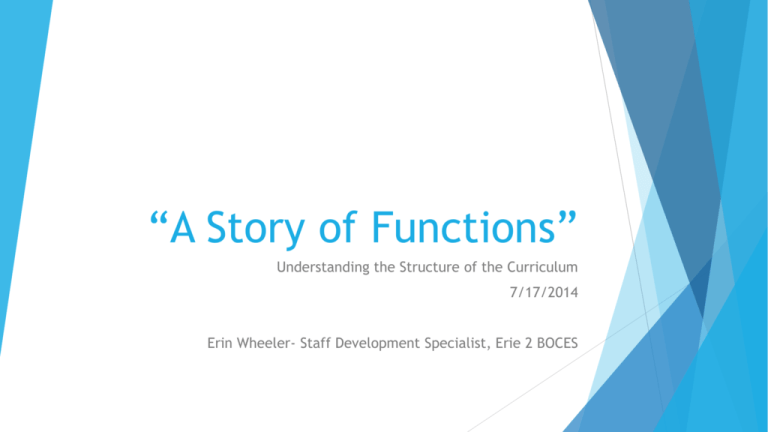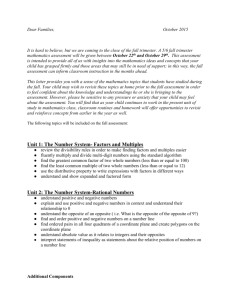
“A Story of Functions”
Understanding the Structure of the Curriculum
7/17/2014
Erin Wheeler- Staff Development Specialist, Erie 2 BOCES
Textbook
What do you think when you hear the word
“textbook?”
What has your relationship with textbooks been
like over the years.
A Different Vision of “Textbook”
Few U.S. textbooks paint mathematics as a dynamic,
unfolding tale. They instead prioritize teaching
procedures and employ a spiraling approach, in which
topics are partially taught and then returned to—
sometimes years later—with the unrealistic expectation
that students will somehow connect the dots. But
teaching procedures as skills without a rich context is
ineffective. Students can too easily forget procedures and
will fail if they do not have deeper, more concrete
knowledge from which they can draw.
“How to Implement a Story of Units” page 4
Teaching Mathematics
Dr. Wu “What is Different About the Common Core Math Standards?”
http://math.berkeley.edu/~wu/CommonCoreVI.pdf June 20, 2011
A Different Vision of “Textbook”
“The textbook is the material on which Chinese
teachers spend most of their time and devote most of
their efforts to “study intensively.” They study it
constantly throughout the school year when they teach it.
(Knowing and Teaching Elementary Mathematics, Ma (1999, pg. 132)
A Different Vision of “Textbook”
First of all, they work for an understanding of “what it
is.” They study how it interprets and illustrates the
ideas in the (Standards), why the authors structured
the book in a certain way, what the connections among
the contents are…
(Knowing and Teaching Elementary Mathematics, Ma (1999, pg. 132)
Coherence at the High School Level
A Trilogy of Mathematics
9-12
6-8
PK-5
A Story of
Units
A Story of Ratios
A Story of
Functions
http://commoncoretools.me/2012/02/16/the-structure-is-the-standards/
Textbooks that brings the world of
mathematics research into the classroom.
What is the goal of my math class?
To be able to solve
a certain type of
problems by the
end of today.
To use the
problems we are
solving today to
learn mathematics.
https://www.youtube.com/watch?v=B6UQcwzyE1U
(Phil Daro- Rationale of the Math Standards 5 min)
A Misconception to Clear Up
http://commoncore.org/
http://www.corestandards.org/about-the-standards/
Curriculum Map and Overview
Story of Functions
Curriculum Maphttps://www.engageny.org/r
esource/grades-9-12mathematics-curriculummap
Interactive Curriculum Maphttp://commoncore.org/ma
ps/math/
Algebra 1 and Geometry Test
Guides
https://www.engageny.org/r
esource/regents-examsmathematics
Going Beyond the Map
http://parcconline.org/sites/parcc/files/PARCCMCFMathematicsNovember2012V3_FINAL_0.pdf
Going Beyond the Map
NYS COMMON CORE MATHEMATICS CURRICULUM
Key Points for Algebra 1
•
Module 1 plants the seeds of the work of the year, connecting the work to real
world contexts, and also provides a deep study of algebraic equivalence, the
structure of expressions, and reasoning of solving equations.
•
Module 2 continues to connect the work of the year to real world contexts from a
data perspective, motivating the intense study of exponential and quadratic
functions to come.
•
Module 3 provides a deep study of exponential functions, introduces function
notation.
•
Module 4 provides a deep study of quadratic functions.
•
Module 5 serves to synthesize the year by providing situations of linear,
exponential, and quadratic forms, where the student is required to recognize the
model to be used.
© 2012 Common Core, Inc. All rights reserved. commoncore.org
A Story of Ratios
NYS COMMON CORE MATHEMATICS CURRICULUM
Key Themes of Geometry Module 1: Congruence, Proof,
and Constructions
•
Module is anchored by the definition of congruence
•
Emphasis is placed on extending the meaning and use of
vocabulary in constructions
•
There is an explicit recall and application of facts learned over
the last few years in unknown angle problems and proofs
•
Triangle congruence criteria are indicators that a rigid motion
exists that maps one triangle to another; each criterion can be
proven to be true with the use of rigid motions.
© 2012 Common Core, Inc. All rights reserved. commoncore.org
A Story of Ratios
NYS COMMON CORE MATHEMATICS CURRICULUM
Key Themes of Geometry Module 2: Similarity, Proof, and
Trigonometry
• Just as rigid motions are used to define congruence, so
dilations are added to define similarity.
• A close look at the way dilations are constructed yields
information about how dilations behave.
• Right triangle similarity is built on the concepts of withintriangle ratios and between-triangle ratios leading to an
understanding of trigonometric ratios.
© 2012 Common Core, Inc. All rights reserved. commoncore.org
A Story of Ratios
Going Beyond the Map
Creating the Curriculum Map
A Story of Units
Module Structure
Module Overview
Topic A
Topic B
Topic C
L1 L2 L3
L4 L5
L6 L7 L8
20
© 2012 Common Core, Inc. All rights reserved. commoncore.org
Overview Narrative
Explains the
sequence outlined on
the title page.
Helps you see where
we’ve been and
where we’re going.
Progressions Documents
“…explain why standards are sequenced the
way they are, point out cognitive
difficulties and pedagogical solutions, and
give more detail on particularly knotty
areas of the mathematics. This would be
useful in teacher preparation and
professional development, organizing
curriculum, and writing textbooks.”
http://ime.math.arizona.edu/progressions/
This seems strange…
http://ime.math.arizona.
edu/progressions/
A Story of Units
Module Structure
Module Overview
Topic A
Topic B
Topic C
L1 L2 L3
L4 L5
L6 L7 L8
Simple
Complex
25
© 2012 Common Core, Inc. All rights reserved. commoncore.org
Making the Connections
9 + 6 = 15
Abstract
Pictorial
Concrete
Universal Design for Learning
Multiple Means of
Representation
Multiple Means of
Action and Expression
Multiple Means of
Engagement
“How to Implement a Story of
Units” Differentiating Instruction
pages 14-20
https://www.engageny.org/resour
ce/pre-kindergarten-grade-5mathematics-curriculum-map-andguiding-documents
NYS COMMON CORE MATHEMATICS CURRICULUM
A Story of Ratios
Types of Lessons
1.
Problem Set
Students and teachers work through examples and complete exercises
to develop or reinforce a concept or procedure.
2.
Socratic
Teacher leads students in a conversation to develop a specific concept
or proof.
3.
Exploration
Independent or small group work on a challenging problem followed
by debrief to clarify, expand or develop math knowledge
4.
Modeling
Students and teacher practice part of the modeling cycle with
problems that are ill-defined and have a real world context.
© 2012 Common Core, Inc. All rights reserved. commoncore.org
Topic Opener- Narrative
Math Publisher’s Criteria
Rigor: in major topics, pursue with equal intensity
• conceptual understanding
• procedural skill and fluency
• applications
http://achievethecore.org/content/upload/Math_Publishers_Criteria_HS_Spring_2013_FINAL.pdf
Fluency
Fluency is designed to promote automaticity by engaging students in practice in
ways that get their adrenaline flowing.
Automaticity is critical so that students avoid using up too many of their attention
resources with lower-level skills when they are addressing higher-level problems.
Set a timer and stop when your fluency time is up!
Fluency follows instruction!
NYS COMMON CORE MATHEMATICS CURRICULUM
What’s In a Lesson?
Teacher Materials Lessons
•
Student Outcomes and Lesson Notes (in select lessons)
•
Classwork
•
General directions and guidance, including timing guidance
•
Bulleted discussion points with expected student responses
•
Student classwork with solutions (boxed)
•
Exit Ticket with Solutions
•
Problem Set with Solutions
Student Materials
•
Classwork
•
Problem Set
© 2012 Common Core, Inc. All rights reserved. commoncore.org
A Story of Ratios
Examples- Developing the Concept
Closing- Debrief the patterns observed
Exit Ticket
• Follows the closing after the student have had an opportunity to
share and hear classmates observations.
• Provides a daily gauge of student understanding.
Problem Set
• Practice applying
the day’s learning.
• Consider a time
frame vs. a task
frame.
Assessments
Evidence of the Standards
Evidence of the Standards
Thank you for attending or watching!












